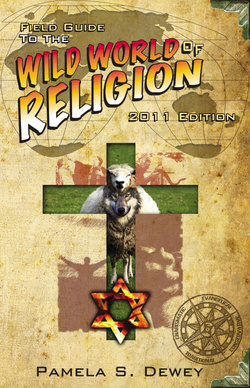Читать книгу Field Guide to the Wild World of Religion: 2011 Edition - Pamela J.D. Dewey - Страница 12
На сайте Литреса книга снята с продажи.
Where were you in ‘62?
ОглавлениеA book titled Faiths, Cults and Sects in America (later titled God is a Millionaire when it came out in paperback) hit the shelves of America’s bookstores in 1962. Authored by Newsweek reporter Richard Mathison, it promised to reveal “the strange beliefs, the swindles, the bizarre teachings and frequently erotic rituals into which millions of Americans pour their faith and money.” His book labeled some groups, such as Mormons, Jehovah’s Witnesses, Seventh Day Adventists, and Unitarians, as “established cults.” Others were farther out on the fringe, such as the flying saucer cults popular at the time, Voodoo cults, and groups centered around some Hindu yogi. Mathison noted:
The National Council of Churches has announced that two thirds of the people in the U.S.—about 104 million in 268 recognized religious bodies—follow some creed or faith with reasonable persistence. Of these a fraction, an estimated six to seven million, belong to the cults and sects which include a wide variety of beliefs, but have in common a recognizable deviation from “normal” Protestantism or Catholicism. Some fundamentalists are assured the world will end any day and have a phrase in the Old Testament to prove it. Others are willing to test the solidity of their faith against the bite of a rattlesnake. Still others seek by ecstatic excitement the immediate, transforming religious experience that will give them a glimpse of True Reality. (p. 13)
All of this is still true. In the 21st Century there are many groups which “deviate from the norm,” many that embrace odd distinctives such as snake-handling or the prediction of imminent Armageddon. What is different now?
What is different is the numbers and distribution of the adherents of these groups of people. Yes, men may have been just as likely to be tempted by porn back in 1962 as in 2005. But the purveyors of porn in 1962 had very limited distribution channels for their wares. Likewise, many folks were susceptible to being attracted to unusual religious claims in 1962. But the purveyors of such claims didn’t have such easy access to potential converts as they do today. Most were limited by the technology of the time to placing an ad in the back of magazines such as Capper’s Farmer, sending out literature via the U.S. mail, and/or broadcasting for a half hour every night, or maybe even only once a week, on an obscure radio station. And these outlets were expensive for the individual just getting started in a ministry. Some relied for developing a following almost exclusively on word of mouth, such as in circles of bored California Society Matrons who were fascinated by the latest claims regarding the most fashionable Hindu yogis who allegedly were in contact with Ascended Masters. While such fellows and their promoters might get followers quickly in the Los Angeles suburbs, their effect on mid-America would be almost non-existent.
It wasn’t easy, prior to the 1970s, to attract a wide following of people for any new religious venture. And even those limited numbers attracted to a new religious novelty were limited in how easily they could feed their new interest. Their opportunities might consist of a booklet or two or newsletter a month sent out by their new teacher of choice, and a catalog of articles one could request. Most groups, even those that could afford to buy radio or TV time, or to produce a glossy monthly magazine to send out to supporters, grew slowly. Sunday morning slots on network stations were expensive or non-existent. Such slots on local channels were perhaps more available, but they reached only a limited audience.
It’s a new world out there now.
